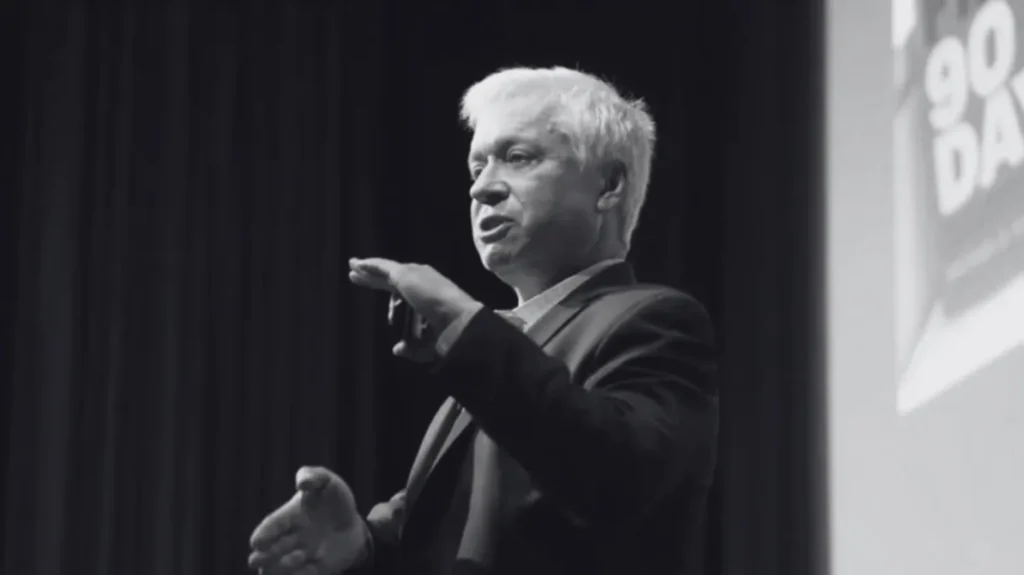
"What got you here won’t get you there — and worse, it might hold you back."
Michael D Watkins
Professor of Leadership
- Date
You Don’t Need More Tips — You Need to Cross the River
posted in Leadership

Adam Kreek
Most people don’t fail because they’re lazy.
They fail because they cling too tightly to old identities, mindsets, and methods that no longer serve them at the next level.
It’s not a character flaw. It’s a crossing.
And like any crossing, it’s confusing, disorienting, and hard to navigate.
That’s why I love the Leadership River metaphor. It’s not a step-by-step ladder. It’s a winding, often wild, body of water. You enter as one kind of leader and (if you don’t drown or bail out) you emerge as something more evolved, more capable, more you.
The Seven Seismic Shifts: Map for the Leadership River
Leadership expert Michael D. Watkins identified seven “seismic shifts” leaders must make when moving from function to enterprise — from high performer to high-impact leader.
Table summary of the seven shifts
You can see a summary in the table below, and more on each subject at the end of the blog.
Let’s look at how those shifts show up in the Leadership River.
1. Specialist to Generalist
You were the go-to person for answers. Now you're the one asking the right questions.
This is the entrance to the river. Early in your career, you built credibility with deep expertise. But as your leadership grows, you need to zoom out and think in systems, not silos.
You’re not the expert in everything — and that’s exactly how it should be.
2. Analyst to Integrator
Stop solving. Start synthesizing.
You’re no longer rewarded for tidy analysis. Your job now is messy. You must reconcile tensions: growth vs. efficiency, innovation vs. risk, today vs. tomorrow.
This is where the river gets choppy. You’ll want to go back to the calm shore of certainty. Don’t. Keep paddling. Integration is your new job.
3. Tactician to Strategist
Stop doing. Start deciding what needs to be done.
Strategists operate upstream. They zoom out, connect patterns, and chart a course based on what’s happening now and next. They also let go of the addiction to urgency.
In this part of the river, the current slows. It looks peaceful, but it’s easy to drift. Steer with purpose.
4. Bricklayer to Architect
Not laying bricks. Designing the building.
You used to build things. Now you build environments where others can build. That means designing the structure, shaping the culture, aligning incentives, and enabling systems that scale.
This shift is humbling. You’re not in control of outcomes — only the conditions that make outcomes possible.
5. Problem-Solver to Agenda-Setter
Stop reacting. Start choosing what problems are worth solving.
You don’t just fix what’s broken. You decide what earns your team’s time, energy, and focus. What you ignore sends just as strong a message as what you pursue.
This is the open water. No clear path. Your decisions shape the direction. Own the role.
6. Warrior to Diplomat
Put down the sword. Pick up the coffee.
Early leadership rewards hustle and drive. But as you scale, you need allies. You need influence. You need to manage complexity, not conquer it.
This is the judo of leadership. It’s not weakness. It’s strategy.
7. Supporting Cast to Lead Role
People are watching. What story are you telling with your life?
You are the culture now. Your words, body language, calendar, and energy — they’re all magnified. Whether you like it or not, you’ve become a symbol.
This is the river’s mouth. If you’ve done the work, you exit into the ocean with a deeper presence and wider influence.
Why This Leadership Framework Matters Now
So many leaders are in the river right now. In transition. Caught between past success and future significance.
The biggest mistake I see? They try to cross in the same boat that got them here.
You can’t.
You need new skills, new habits, and most of all — a new identity grounded in your values.
Values are your rudder. When the current is strong and the fog rolls in, they keep you upright and aligned. They remind you who you are and what matters.
The Seven Seismic Shifts give us a map. The Leadership River reminds us that change is inevitable — and necessary.
You’re Not Failing — You’re Evolving
If you’re feeling wobbly right now — more meetings, less certainty, more politics, fewer wins — it’s not because you’re failing.
It’s because you’re being asked to evolve.
And yes, it’s hard.
But the greatest leaders are river-tested. They made the seismic shifts. They navigated unknowns. They let go of the old — and grew into the leader their team needed.
If you’re in the river, keep going.
You’re not broken. You’re crossing.
Final Thought
You don’t need more tips. You need a new identity — one that can weather the crossing and lead on the other side.